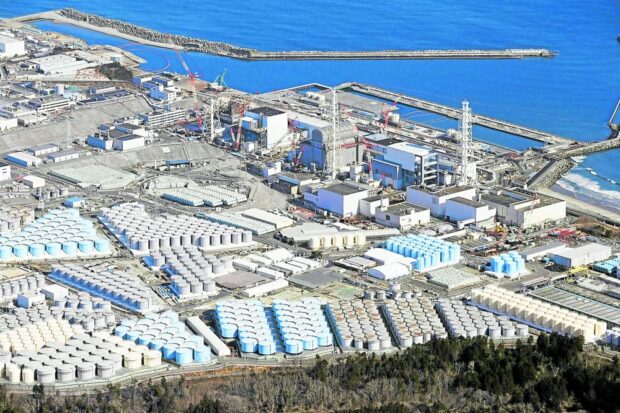Scientist: Fukushima wastewater disposal won’t affect PH waters

RADIOACTIVE CONTENT This 2021 photograph shows the storage tanks for treated water at the tsunami-crippled Fukushima Daiichi nuclear power plant. —KYODO VIA REUTERS
Japan’s plan to dump treated wastewater from its Fukushima nuclear plant into the Pacific Ocean will have a negligible effect on Philippine waters, an environmental science professor has assured the public, especially fisherfolk alarmed by its potential impact on fish and other marine life.
Hernando Bacosa, a professor at the Mindanao State University-Iligan Institute of Technology, said any discharged wastewater would have little to no direct impact on the Philippines, since it no longer contained high-risk radionuclides.
“Considering the highly dynamic nature of the sea with continuous dilution, this has likely negligible impact on the marine environment of the Philippines,” the scientist told the Inquirer on Sunday.
Bacosa served as a research scientist at Tohoku University in Japan when the Fukushima nuclear disaster happened following the earthquake and tsunami of 2011, and was involved in research about the consequences of the accident.
He emphasized, however, that Tokyo Electric Power Co. (Tepco), which ran the destroyed Fukushima Daiichi nuclear power plant, should keep monitoring the level of radioactive contents of fish, seafood and water, as the planned disposal would take three to four decades to complete.
Article continues after this advertisementIn March 2011, a devastating magnitude 9.1 earthquake hit the northeast coast of Japan, damaging the Fukushima nuclear power plant’s supply and cooling system.
Article continues after this advertisementTo cool the reactors, Tepco has been pumping water into the plant, resulting in the accumulation of an estimated 1.33 million cubic meters of water on the site, which now needs to be disposed.
Tepco, according to Bacosa, has been removing high-risk radioactive materials like cesium and strontium from the contaminated water through an Advanced Liquid Processing System.
“During the wastewater treatment, these were removed and what was left are Carbon 14 and tritium, the radioactive form of hydrogen. [These two] are very less reactive,” he said.
Gradual discharge
Tritium’s impact on the marine environment depends on its concentration and the exposure of organisms to it, he noted.
If Tepco would dump 1.33 million cubic tons right away, that would pose an alarming risk to marine organisms like fish or shellfish, Bacosa said.
But with a gradual discharge, he said, the worst-case scenario is that marine organisms and seafood could be exposed to tritium, though still at a “safe level.”
Fisherfolk groups, however, have expressed strong opposition to the wastewater disposal, citing potential adverse impact on their livelihood.
“We demand the Japanese government to stop the plan to dump Fukushima nuclear wastewaters into the Pacific Ocean to save the fishermen’s livelihood, to ensure the safety of foods for the public and to uphold sustainability of the Pacific Ocean for the whole world,” Bryan Valenzuela of Nagsama-Lamon Bay Fisherfolk Federation said in a recent Pandesal forum in Quezon City.
Edlyn Rosales, chair of Pangisda Bataan, pointed out that the Pacific was already facing different types of pollution like plastics or microplastics and nuclear weapon testing.
“This untenable situation will only be worsened by the plan to dispose of the Fukushima radioactive wastewater into the ocean,” she said.
During an online forum organized by Earth Island Institute Philippines, Derek Cabe of the Nuclear Free Bataan Movement cited concerns raised by scientists regarding issues on the planned disposal, such as “deficiencies in ecosystem impact analysis” and “lack of adequate and accurate scientific data on the safety of the release.”
On July 7, the proposed plan to release the Fukushima water cleared its last regulatory hurdle in Japan as the International Atomic Energy Agency (IAEA) concluded the safety review of Japan’s plan.
“The IAEA notes the controlled, gradual discharges of the treated water to the sea, as currently planned and assessed by Tepco, would have a negligible radiological impact on people and the environment,” IAEA Director General Rafael Mariano Grossi said.
The report comes after almost two years of comprehensive assessment of the IAEA task force composed of top specialists from the agency, who were advised by internationally recognized nuclear safety experts from 11 countries.
While it recognized that the discharge had raised societal, political and environmental concerns, IAEA said its assessment concluded that Japan’s approach was “consistent with relevant international safety standards.” INQ